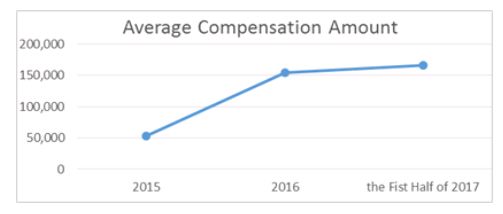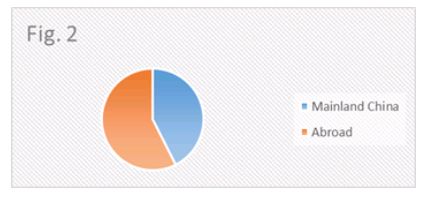In recent years, China's intellectual property legislation has been continuously improved, and protection of intellectual property rights has been constantly strengthened, which is particularly evident in a patenting system that is most closely related to China's national policy for the promotion of innovation. At the legislative level, the State Intellectual Property Office of China (SIPO) is promoting the fourth revision of the Patent Law of the People's Republic of China. At the judicial level, the Supreme People's Court issued two judicial interpretations of patent infringement disputes in 2015 and 2016, respectively, and related judicial guidance documents in response to the long-standing issue of "low compensation" in patent litigation.
Changes in Legal Norms for Patent Infringement Compensation
Provisions for patent infringement compensation are set forth in Article 65 in the latest amendments to the patent law (draft). On the basis of the initial provisions, a punitive compensation system for intentional patent infringement will be introduced. It is provided in Article 65 of the draft amendments that, "for the intentional Patent Infringement, the people's court may, according to such factors as the circumstances, scale and consequence of the infringement, the amount of compensation determined according to the previous two paragraphs shall be increased to two to three times." Punitive compensation to intentional infringement will serve as a further deterrent to such acts of intentional infringement as repeated infringement or the like.
In the Regulations on the Application of Law in the Trial of Patent Dispute Cases, promulgated by the Supreme People's Court of the People's Republic of China in 2015, limitations over the amount of statutory compensation for patent infringement have been deleted, and "generally from Rmb5,000 to Rmb300,000, with a maximum not exceeding Rmb500,000" in the initial provisions of determining the amount of compensation was amended to "determining the amount of compensation in accordance with the provisions of Paragraph 2 of Article 65 of the Patent Law on the basis of such factors as the type of patent right, the nature and circumstances of the infringement." (Regarding the compensation amounts listed above, Rmb5,000 is US$753, Rmb300,000 is US$45, 170 and Rmb500,000 is US$72,285.)
The Interpretation (II) on a Number of Issues Regarding the Application of Law in the Trial of Patent Infringement Cases, promulgated by the Supreme People's Court in 2016, provides a solution for the difficultly of providing proof in patent infringement litigation as well as for low compensation. Article 27 of this judicial interpretation makes some improvements to the rules of proof for the amount of compensation in patent infringement litigation. According to the preliminary proof of the patentee and the relevant evidence possessed by the infringer, the burden of proof on profits obtained by the infringer is assigned to the infringer, and this shall be in line with the order of calculation of the amount of compensation provided in Art. 65 of the Patent Law.
It is particularly indicated in the Outline of China's Intellectual Property Protection (2016-2020), issued by the Supreme People's Court in 2017, that a scientific and rational intellectual property infringement compensation system shall be established, and a compensation system compatible with the value of the intellectual property shall be established, taking into consideration of the loss of the patentee, the profit obtained by the infringer, the license fee, the statutory compensation and costs in safeguarding the rights and interests.
Continuously Increased Amounts of Patent Infringement Compensation in Judicial Practice
By making a statistical analysis of the winning cases in patent infringement litigation in the past three years, it is found that the amount of compensation obtained by the patentees has shown a significant rising trend. The average amounts of compensation ruled in 2015, 2016 and the first half of 2017 are Rmb350,000 (US$52,660), Rmb1.024 million (US$154,075) and Rmb1.103 million (US$165,911), respectively.

Figure 1. Compensation amounts received by patentees in China in 2015, 2016 and the first half of 2017.
The percentage of the amount of compensation imposed by the court to the amount of compensation claimed by the patentee is also increased year-on-year. The average percentages in 2015, 2016 and the first half of 2017 are 44.6%, 57.6% and 87.7%, respectively. In terms of the amount of compensation, the average amount of compensation obtained by patentees from abroad or from Hong Kong, Macau and Taiwan is Rmb1.022 million (US$153,896), significantly more than the average amount of compensation of Rmb757,000 (US$113,992) obtained by patentees from mainland China over the same period (Data Source: Beijing Intellectual Property Court official WeChat, Intellectual Property Beijing).

Figure 2. Amount of compensation, expressed as a percentage of the whole, for patentees from mainland China (Rmb757,000,US$113,835 ) as compared to patentees from abroad, including Hong Kong, Macau and Taiwan (Rmb1.022 million, US$), from 2015 through the first half of 2017.
Statutory Compensation is Still the Mainstream in Judicial Practice, but the Number of Cases Exceeding the Amount of Statutory Compensation is Gradually Increasing
According to the provisions of the Chinese Patent Law, the amount of patent infringement compensation shall be calculated by using the following methods, and these methods are in an applicable consecutive sequence as the following: (1) the losses suffered by patentee due to infringement; (2) the profits obtained by the infringer from the infringement; (3) a reasonable multiple of the patent license fee shall be referred to; (4) statutory compensation (Rmb10,000-Rmb1 million [US$1,506-US$150,567]).
In judicial practice, the losses suffered by the patentee in the first consecutive place are often difficult to prove and are rarely used. Submission of evidence of the profits of the infringer obtained from the infringement in the second consecutive place is usually necessary for obtaining a large amount of compensation. A reasonable multiple of the patent license fee in the third consecutive place is not commonly seen in judicial practice. Where the specific amounts in the preceding three consecutive places cannot be proved according to the evidence of the case, the court may apply the statutory compensation according to the circumstances of the case. If the evidence provided by the parties concerned or the evidence collected in investigation can prove that the applicable statutory compensation is obviously unfair, an amount may be imposed above the upper limit of the statutory compensation.
Evidence is obtained by preservation of evidence of the profits obtained by the alleged infringer. In the patent infringement case of Zhengtai Company v. Schneider Electric Low Voltage (Tianjin) Co., Ltd., the Wenzhou City Intermediate People's Court of Zhejiang Province determined a profit of Rmb355 million (US$50.4 million) obtained from the infringement by calculating an average operating profit of Schneider according to the financial material from the industrial and commercial administration and tax department by preserving as evidence sales documents of the allegedly infringing products.
Sales data for publicity on websites or other media and sales data from e-business platforms can be used as the preliminary basis for the amount of infringing sales. The industry's average profit margins can be used as the profit margins of the accused product. The alleged infringer's turnover for publicity can also be used as the preliminary evidence of the profits obtained from the infringement. Submission of this evidence is conducive to the judge to determine an amount of compensation within or beyond the amount of statutory compensation. In patent infringement cases such as Stricker v. Fada, the court ruled that the defendant's financial accounts and so on shall be preserved as evidence, but the defendant refused to perform the ruling. However, the patentee submitted evidence to prove that the defendant's website proclaims an annual turnover of the infringing product of Rmb50 million to Rmb100 million (US$7.5 million to US$15 million), and a monthly output of the infringing product of 600,000 sets. Thus, the court ruled on this basis that the defendant shall pay an amount of compensation of Rmb2 million (US$301,170).
Conclusion
China's patent infringement compensation system is gradually becoming established. Patent infringement costs are increasing year-by-year, and costs for safeguarding patent rights are decreasing. In judicial practice, patentees attach importance to providing evidence of infringement, but ignore the provision of evidence for infringement compensation, which leads to the application of statutory compensation where the judge makes a judgment and chooses an amount of compensation by considering factors such as the type of patent right infringed upon, circumstances surrounding the infringement and the duration of the infringement.
However, regarding such cases for which the exact amount of losses or profits from the infringement is difficult to prove, so in order to exceed the limits on statutory compensation, the patentee may submit evidence to prove that the applied statutory compensation is obviously unfair, in which case, the court may use the evidence in the case to determine an appropriate amount of compensation over the statutory limit. Where it is impossible to obtain evidence of the infringement of the defendant, on the basis of the submission of preliminary evidence to prove that the infringer obtained far more profit than the statuary compensation, the patentee may request the court to collect evidence for the profits obtained by the defendant from the infringement by making investigation. If the infringer refuses to provide the evidence, it shall bear unfavorable legal consequences. The system of punitive compensation for intentional infringement is currently only embodied in the draft legislation of the patent law; it remains to be observed whether or not it will become a formal legal provision.
The content of this article is intended to provide a general guide to the subject matter. Specialist advice should be sought about your specific circumstances.
